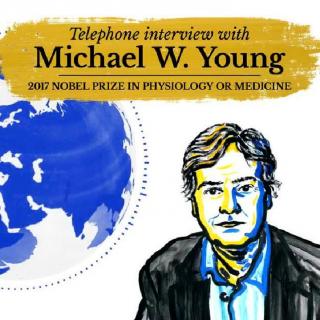
介绍:
Telephone Interview with Michael W. Young
Telephone interview with Michael W. Young following the announcement of the 2017 Nobel Prize in Physiology or Medicine, 2 October 2017. The interviewer is Adam Smith, Chief Scientific Officer of Nobel Media.
[Michael W. Young] Hello.
[Adam Smith] Oh. Good morning. My name’s Adam Smith, calling from Nobelprize.org. Congratulations on the award of the Nobel Prize…
[Michael W. Young] Well, thanks, thanks. We’ve got multiple phones in the room running here, my wife’s going to get the other one.
[Adam Smith] [Laughs] Yes, you’re going to be bombarded from this point on.
[Michael W. Young] Yes, this is…this is…this is crazy. I’m... I just told somebody I’m not quite sure how I’m going to get through the day. [Laughs] I need to…I need to replicate myself.
[Adam Smith] [Laughs] But it all must seem a little unreal – I mean – not [having] actually heard from the Committee, so you…you’re hearing it second hand, so to speak.
[Michael W. Young] I don’t know. Somehow…somehow, it’s just all spinning around in my head that this has happened. You know, you know about these things and you can…you can see possibilities on the horizon, but you never really…Has this really happened? [Laughs.] You know, I’m still at that stage.
[Adam Smith] It’s hard to remember how things were 30 years ago and nowadays, the idea of linking genes with behaviour is sort of, people expect that. But then it was a very pioneering thing to do.
[Michael W. Young] Oh, yeah. I mean this was... you know, I had gone to Stanford to learn how to use this technology, it was brand new in the 70s. And starting up my lab at Rockefeller, I had…I had worked a little bit on this problem, circadian rhythms, thanks to these tremendous mutants that Seymour Benzer and his student Ron Konopka had found. And…and I just thought it was a terrific problem and maybe the toughest thing I could try to tackle because it was behaviour; you know, what…what…what could we learn about a fairly complicated behaviour that we all exhibit, which was, you know, most easily represented by sleep-wake cycles. And frankly, I thought we might find out maybe a little bit. I never thought we would really understand what the motor behind this was, at the time. We were very lucky, we…we…we managed to find genes that fit together like puzzle pieces to explain how another thing worked. And…and the techniques and the approaches kept changing and I kept...I was very lucky, I kept getting students and post docs that were extremely good and…and just did everything right. And the other piece of this was, you know, there was sort of a race going on in the early years. My colleagues Jeff Hall and Michael Rosbash and we kind of pushed each other along because…I mean, most of…most of it was independently done, but we did have to collaborate from time to time, but we worked on slightly different problems, but the solutions to those problems all, as I was saying, fit together like puzzle pieces, that kind of bring the picture into view. It was…it was…it’s been really quite satisfying. This is…you know, this…this really pushes its way…way, over the top. It’s…it’s really quite incredible. And I couldn’t...Yeah, this is terribly exciting, as you can imagine.
[Adam Smith] You…you do sound wonderfully amazed, it’s…it’s very nice to hear.
[Michael W. Young] Oh, I am. I’m just…I’m just, like I think I said, I’m just wondering how I’m going to get through the day.
[Adam Smith] Will we be seeing you in Stockholm in December?
[Michael W. Young] Of course. Are you kidding? [Laughs] I’ll be there, I’ll be there.
大家还在听

